八年级英语上册 Unit 4 Do it yourself教案
- 格式:doc
- 大小:74.00 KB
- 文档页数:16
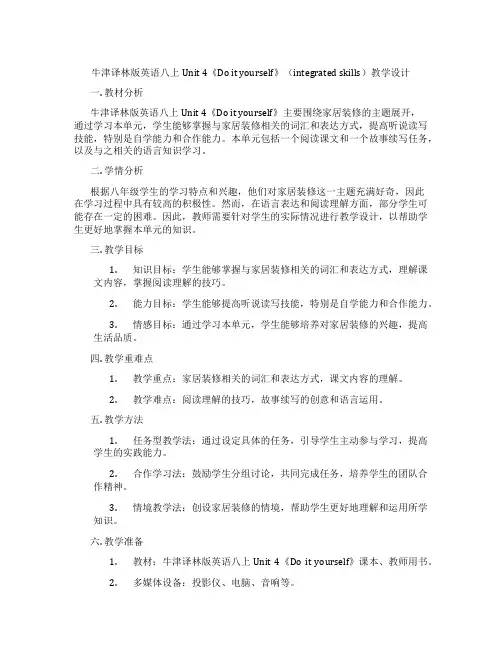
牛津译林版英语八上Unit 4《Do it yourself》(integrated skills)教学设计一. 教材分析牛津译林版英语八上Unit 4《Do it yourself》主要围绕家居装修的主题展开,通过学习本单元,学生能够掌握与家居装修相关的词汇和表达方式,提高听说读写技能,特别是自学能力和合作能力。
本单元包括一个阅读课文和一个故事续写任务,以及与之相关的语言知识学习。
二. 学情分析根据八年级学生的学习特点和兴趣,他们对家居装修这一主题充满好奇,因此在学习过程中具有较高的积极性。
然而,在语言表达和阅读理解方面,部分学生可能存在一定的困难。
因此,教师需要针对学生的实际情况进行教学设计,以帮助学生更好地掌握本单元的知识。
三. 教学目标1.知识目标:学生能够掌握与家居装修相关的词汇和表达方式,理解课文内容,掌握阅读理解的技巧。
2.能力目标:学生能够提高听说读写技能,特别是自学能力和合作能力。
3.情感目标:通过学习本单元,学生能够培养对家居装修的兴趣,提高生活品质。
四. 教学重难点1.教学重点:家居装修相关的词汇和表达方式,课文内容的理解。
2.教学难点:阅读理解的技巧,故事续写的创意和语言运用。
五. 教学方法1.任务型教学法:通过设定具体的任务,引导学生主动参与学习,提高学生的实践能力。
2.合作学习法:鼓励学生分组讨论,共同完成任务,培养学生的团队合作精神。
3.情境教学法:创设家居装修的情境,帮助学生更好地理解和运用所学知识。
六. 教学准备1.教材:牛津译林版英语八上Unit 4《Do it yourself》课本、教师用书。
2.多媒体设备:投影仪、电脑、音响等。
3.教学素材:与家居装修相关的图片、视频、阅读材料等。
4.学习任务单:用于学生分组讨论和完成任务。
七. 教学过程1.导入(5分钟)教师通过展示一些家居装修的图片,引导学生谈论他们对家居装修的看法,激发学生的学习兴趣。
2.呈现(10分钟)教师呈现课文内容,引导学生关注家居装修的词汇和表达方式,如“repr”、“renovate”等。
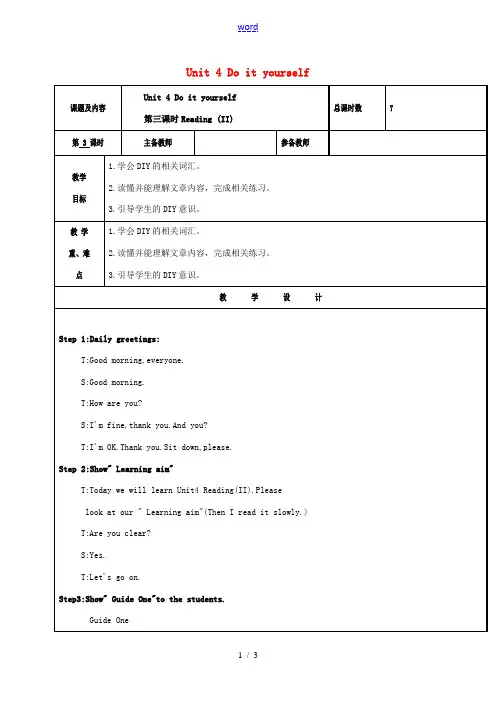
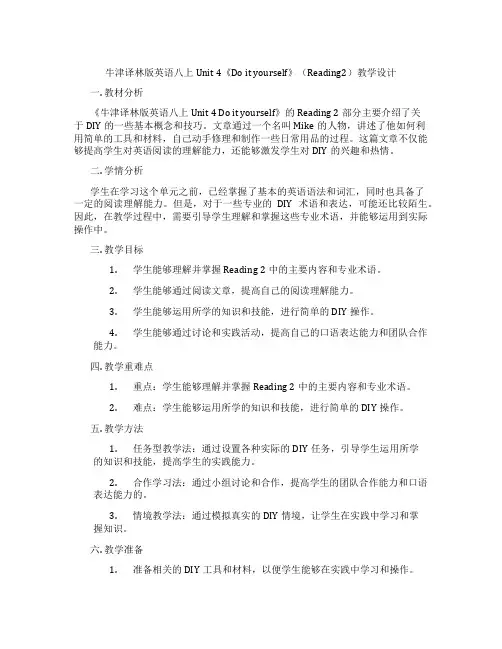
牛津译林版英语八上Unit 4《Do it yourself》(Reading2)教学设计一. 教材分析《牛津译林版英语八上Unit 4 Do it yourself》的Reading 2部分主要介绍了关于DIY的一些基本概念和技巧。
文章通过一个名叫Mike的人物,讲述了他如何利用简单的工具和材料,自己动手修理和制作一些日常用品的过程。
这篇文章不仅能够提高学生对英语阅读的理解能力,还能够激发学生对DIY的兴趣和热情。
二. 学情分析学生在学习这个单元之前,已经掌握了基本的英语语法和词汇,同时也具备了一定的阅读理解能力。
但是,对于一些专业的DIY术语和表达,可能还比较陌生。
因此,在教学过程中,需要引导学生理解和掌握这些专业术语,并能够运用到实际操作中。
三. 教学目标1.学生能够理解并掌握Reading 2中的主要内容和专业术语。
2.学生能够通过阅读文章,提高自己的阅读理解能力。
3.学生能够运用所学的知识和技能,进行简单的DIY操作。
4.学生能够通过讨论和实践活动,提高自己的口语表达能力和团队合作能力。
四. 教学重难点1.重点:学生能够理解并掌握Reading 2中的主要内容和专业术语。
2.难点:学生能够运用所学的知识和技能,进行简单的DIY操作。
五. 教学方法1.任务型教学法:通过设置各种实际的DIY任务,引导学生运用所学的知识和技能,提高学生的实践能力。
2.合作学习法:通过小组讨论和合作,提高学生的团队合作能力和口语表达能力的。
3.情境教学法:通过模拟真实的DIY情境,让学生在实践中学习和掌握知识。
六. 教学准备1.准备相关的DIY工具和材料,以便学生能够在实践中学习和操作。
2.准备一些与DIY相关的词汇和表达,以便在教学中进行操练和巩固。
3.准备一些与DIY相关的图片和视频,以便在教学中进行展示和说明。
七. 教学过程1.导入(5分钟)通过向学生展示一些与DIY相关的图片和视频,引导学生对DIY产生兴趣和好奇心,激发学生的学习热情。
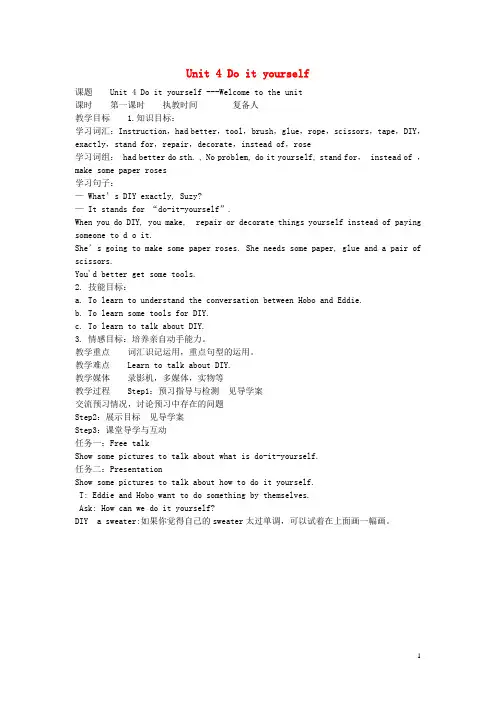
Unit 4 Do it yourself课题Unit 4 Do it yourself ---Welcome to the unit课时第一课时执教时间复备人教学目标 1.知识目标:学习词汇:Instruction,had better,tool,brush,glue,rope,scissors,tape,DIY,exactly,stand for,repair,decorate,instead of,rose学习词组: had better do sth. , No problem, do it yourself, stand for, instead of ,make some paper roses学习句子:—What’s DIY exactly, Suzy?—It stands for “do-it-yourself”.When you do DIY, you make, repair or decorate things yourself instead of paying someone to d o it.She’s going to make s ome paper roses. She needs some paper, glue and a pair of scissors.You'd better get some tools.2. 技能目标:a. To learn to understand the conversation between Hobo and Eddie.b. To learn some tools for DIY.c. To learn to talk about DIY.3. 情感目标:培养亲自动手能力。
教学重点词汇识记运用,重点句型的运用。
教学难点Learn to talk about DIY.教学媒体录影机,多媒体,实物等教学过程Step1:预习指导与检测见导学案交流预习情况,讨论预习中存在的问题Step2:展示目标见导学案Step3:课堂导学与互动任务一:Free talkShow some pictures to talk about what is do-it-yourself.任务二:PresentationShow some pictures to talk about how to do it yourself.T: Eddie and Hobo want to do something by themselves.Ask: How can we do it yourself?DIY a sweater:如果你觉得自己的sweater太过单调,可以试着在上面画一幅画。
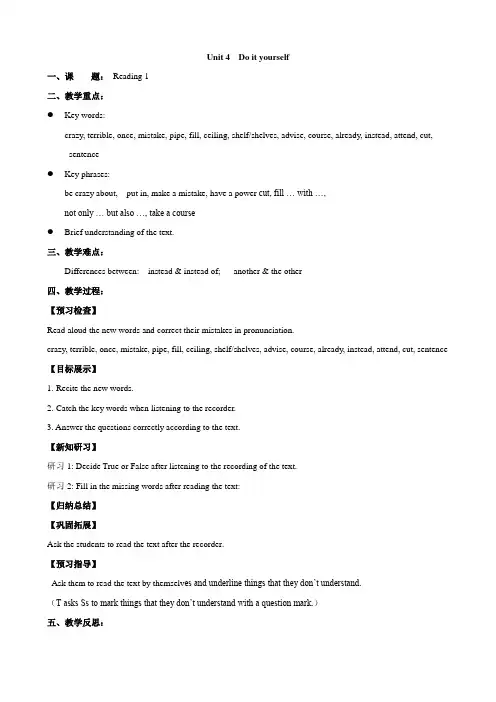
Unit 4 Do it yourself一、课题:Reading 1二、教学重点:●Key words:crazy, terrible, once, mistake, pipe, fill, ceiling, shelf/shelves, advise, course, already, instead, attend, cut, sentence●Key phrases:be crazy about, put in, make a mistake, have a power cut, fill … with …,not only … but also …, take a course●Brief understanding of the text.三、教学难点:Differences between: instead & instead of; another & the other四、教学过程:【预习检查】Read aloud the new words and correct their mistakes in pronunciation.crazy, terrible, once, mistake, pipe, fill, ceiling, shelf/shelves, advise, course, already, instead, attend, cut, sentence 【目标展示】1. Recite the new words.2. Catch the key words when listening to the recorder.3. Answer the questions correctly according to the text.【新知研习】研习1: Decide True or False after listening to the recording of the text.研习2: Fill in the missing words after reading the text:【归纳总结】【巩固拓展】Ask the students to read the text after the recorder.【预习指导】Ask them to read the text by themselv es and underline things that they don’t understand.(T asks Ss to mark things that they don’t understand with a question mark.)五、教学反思:。
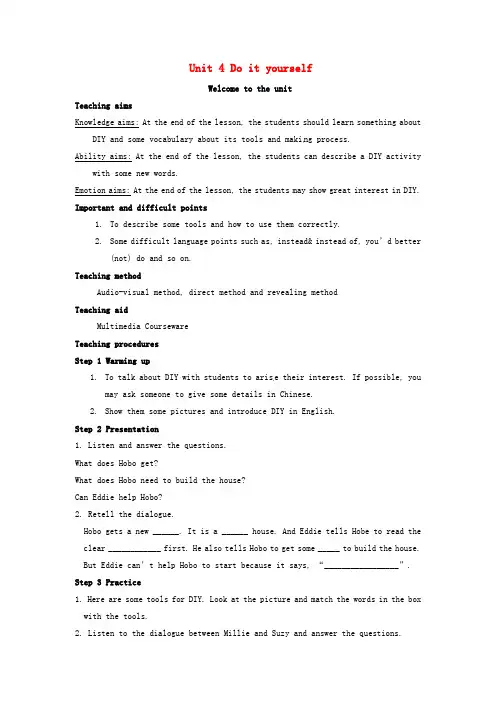
Unit 4 Do it yourselfWelcome to the unitTeaching aimsKnowledge aims: At the end of the lesson, the students should learn something about DIY and some vocabulary about its tools and maki ng process.Ability aims: At the end of the lesson, the students can describe a DIY activity with some new words.Emotion aims: At the end of the lesson, the students may show great interest in DIY. Important and difficult points1.To describe some tools and how to use them correctly.2.Some difficult language points such as, instead& instead of, you’d better(not) do and so on.Teaching methodAudio-visual method, direct method and revealing methodTeaching aidMultimedia CoursewareTeaching proceduresStep 1 Warming up1.To talk about DIY with students to aris e their interest. If possible, youmay ask someone to give some details in Chinese.2.Show them some pictures and introduce DIY in English.Step 2 Presentation1. Listen and answer the questions.What does Hobo get?What does Hobo need to build the house?Can Eddie help Hobo?2. Retell the dialogue.Hobo gets a new ______. It is a ______ house. And Eddie tells Hobe to read theclear ____________ first. He also tells Hobo to get some _____ to build the house.But Eddie can’t help Hobo to start because it says, “_________________”.Step 3 Practice1. Here are some tools for DIY. Look at the picture and match the words in the boxwith the tools.2. Listen to the dialogue between Millie and Suzy and answer the questions.What does DIY stand for?What do you exactly do when you do DIY?How does Suzy like DIY?Keys: It stands for “do-it-yourself”.You need to make, repair or decorate things yourself.Suzy enjoys it very much.3. Read the dialogue.Millie: What’s DIY exactly, Suzy?Suzy: It s tands for “do-it-yourself”. When you do DIY, you make, repair or decorate things yourself instead of paying someone to do it.Millie: What are you going to do then?Suzy: I’m going to make some paper roses.Millie: It sounds lovely. What do you need for that?Suzy: I need some paper, glue and a pair of scissors.Millie: Do you like DIY?Suzy: Yes, I do. I enjoy making something new. That’s fun.Step 4 Language points1. Here are clear instructions.1) instruction n.在表示说明或者指示的时候,往往用复数形式。
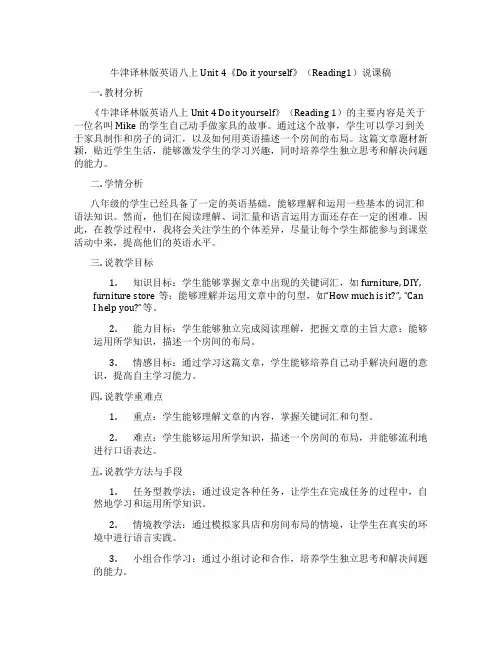
牛津译林版英语八上Unit 4《Do it yourself》(Reading1)说课稿一. 教材分析《牛津译林版英语八上Unit 4 Do it yourself》(Reading 1)的主要内容是关于一位名叫Mike的学生自己动手做家具的故事。
通过这个故事,学生可以学习到关于家具制作和房子的词汇,以及如何用英语描述一个房间的布局。
这篇文章题材新颖,贴近学生生活,能够激发学生的学习兴趣,同时培养学生独立思考和解决问题的能力。
二. 学情分析八年级的学生已经具备了一定的英语基础,能够理解和运用一些基本的词汇和语法知识。
然而,他们在阅读理解、词汇量和语言运用方面还存在一定的困难。
因此,在教学过程中,我将会关注学生的个体差异,尽量让每个学生都能参与到课堂活动中来,提高他们的英语水平。
三. 说教学目标1.知识目标:学生能够掌握文章中出现的关键词汇,如furniture, DIY,furniture store等;能够理解并运用文章中的句型,如“How much is it?”, “CanI help you?”等。
2.能力目标:学生能够独立完成阅读理解,把握文章的主旨大意;能够运用所学知识,描述一个房间的布局。
3.情感目标:通过学习这篇文章,学生能够培养自己动手解决问题的意识,提高自主学习能力。
四. 说教学重难点1.重点:学生能够理解文章的内容,掌握关键词汇和句型。
2.难点:学生能够运用所学知识,描述一个房间的布局,并能够流利地进行口语表达。
五. 说教学方法与手段1.任务型教学法:通过设定各种任务,让学生在完成任务的过程中,自然地学习和运用所学知识。
2.情境教学法:通过模拟家具店和房间布局的情境,让学生在真实的环境中进行语言实践。
3.小组合作学习:通过小组讨论和合作,培养学生独立思考和解决问题的能力。
六. 说教学过程1.导入:通过展示一些家具的图片,引导学生谈论自己喜欢的家具,激发学生的学习兴趣。
2.阅读理解:学生独立阅读文章,回答相关问题,检查学生的理解程度。

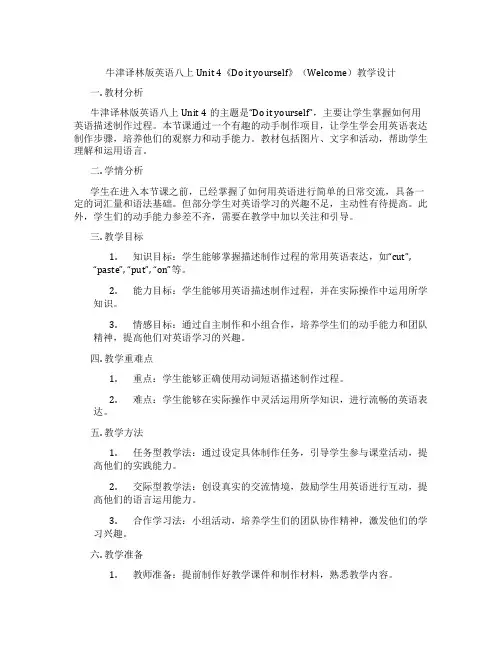
牛津译林版英语八上Unit 4《Do it yourself》(Welcome)教学设计一. 教材分析牛津译林版英语八上Unit 4的主题是“Do it yourself”,主要让学生掌握如何用英语描述制作过程。
本节课通过一个有趣的动手制作项目,让学生学会用英语表达制作步骤,培养他们的观察力和动手能力。
教材包括图片、文字和活动,帮助学生理解和运用语言。
二. 学情分析学生在进入本节课之前,已经掌握了如何用英语进行简单的日常交流,具备一定的词汇量和语法基础。
但部分学生对英语学习的兴趣不足,主动性有待提高。
此外,学生们的动手能力参差不齐,需要在教学中加以关注和引导。
三. 教学目标1.知识目标:学生能够掌握描述制作过程的常用英语表达,如“cut”,“paste”, “put”, “on”等。
2.能力目标:学生能够用英语描述制作过程,并在实际操作中运用所学知识。
3.情感目标:通过自主制作和小组合作,培养学生们的动手能力和团队精神,提高他们对英语学习的兴趣。
四. 教学重难点1.重点:学生能够正确使用动词短语描述制作过程。
2.难点:学生能够在实际操作中灵活运用所学知识,进行流畅的英语表达。
五. 教学方法1.任务型教学法:通过设定具体制作任务,引导学生参与课堂活动,提高他们的实践能力。
2.交际型教学法:创设真实的交流情境,鼓励学生用英语进行互动,提高他们的语言运用能力。
3.合作学习法:小组活动,培养学生们的团队协作精神,激发他们的学习兴趣。
六. 教学准备1.教师准备:提前制作好教学课件和制作材料,熟悉教学内容。
2.学生准备:带好制作材料,提前了解制作步骤。
七. 教学过程1.导入(5分钟)教师通过提问方式引导学生回顾已学过的动词短语,为新课学习做好铺垫。
例如:“Can you remember the verb phrases we learned last class? Now let’s try to use them in a new context.”2.呈现(10分钟)教师展示本节课的制作项目,让学生观察并描述制作步骤。
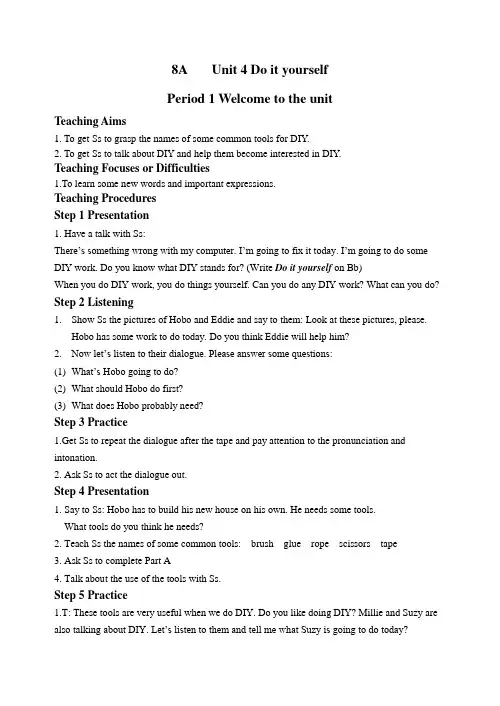
8A Unit 4 Do it yourselfPeriod 1 Welcome to the unitTeaching Aims1. To get Ss to grasp the names of some common tools for DIY.2. To get Ss to talk about DIY and help them become interested in DIY.Teaching Focuses or Difficulties1.To learn some new words and important expressions.Teaching ProceduresStep 1 Presentation1. Have a talk with Ss:There’s something wrong with my computer. I’m going to fix it today. I’m going to do some DIY work. Do you know what DIY stands for? (Write Do it yourself on Bb)When you do DIY work, you do things yourself. Can you do any DIY work? What can you do? Step 2 Listening1.Show Ss the pictures of Hobo and Eddie and say to them: Look at these pictures, please.Hobo has some work to do today. Do you think Eddie will help him?2.Now let’s listen to their dialogue. Please answer some questions:(1)What’s Hobo going to do?(2)What should Hobo do first?(3)What does Hobo probably need?Step 3 Practice1.Get Ss to repeat the dialogue after the tape and pay attention to the pronunciation and intonation.2. Ask Ss to act the dialogue out.Step 4 Presentation1. Say to Ss: Hobo has to build his new house on his own. He needs some tools.What tools do you think he needs?2. Teach Ss the names of some common tools: brush glue rope scissors tape3. Ask Ss to complete Part A4. Talk about the use of the tools with Ss.Step 5 Practice1.T: These tools are very useful when we do DIY. Do you like doing DIY? Millie and Suzy are also talking about DIY. Let’s listen to them and tell me what Suzy is going to do today?2. Ask Ss to practice reading the dialogue in pairs.3. Get Ss to talk about DIY.Make some similar dialogues using the conversation in part B as a model.4. Invite some pairs to the front and act their dialogues out.Step 6 Homework1. Recite the new words and expressions.2. Preview the Reading part.3.Finish the paper.8A Unit 4 Do it yourselfPeriod 2 Reading1Teaching Aims1.To get Ss to grasp some new words about DIY.2.To read the text to understand the content and do some exercises correctly.3.To encourage Ss to do some DIY work.Teaching Focuses or DifficultiesTo read the text to understand the content and do some exercises correctly. Teaching ProceduresStep 1 Lead-inA free talk with Ss:Do you like DIY? Have you ever tried DIY? What’s it?Step 2 Pre-reading1. Tell Ss that Suzy’s cousin Andrew likes DIY a lot. He’s crazy about DIY. Teach ‘be crazy about’2. Show Ss the picture o Page 44 and ask: What happened to Andrew?Encourage Ss to answer the question: He tried to hit the nail with a hammer, but he hit a pipe and filled the room with water. He made a mistake. It was terrible.3. Get Ss to complete Part B1.4. T: Do you think Suzy’s cousin is good at DIY?No, he isn’t. He caused a lot of problems when he did things himself.Step 3 While-reading1. Go through the text and complete Part B2.2. Play the tape for Ss and ask them to do some “T or F” exercises. If the sentence is false, ask Ss to correct it.3. Read Para 1 and answer some questions:Does Andrew like DIY?How is his house after he finishes DIY?1.Give Ss some key words and useful expressions and ask them to retell the text oneparagraph by one paragraph.2.Give Ss three minutes to get ready for retelling the whole story.Step 5 homework1.Read text aloud and try to remember the new words.2.Underline the useful phrases in the text.Blackboard Writing8A Unit 4 Do it yourselfPeriod 3 Reading(2)Teaching Aims1.To enable Ss to retell the text.2.To enable Ss to grasp some useful expressions: be crazy about, fill… with…,advise sb. to do sth., not only… but also…, make a mistake,…Teaching Focuses or DifficultiesTo enable Ss to grasp some language points.Teaching ProceduresStep 1 Revision1.Say to Ss: We’ve learnt something about Suzy’s cousin Andrew.Tell me something about him.2.Give Ss some key words and ask them to retell the text one paragraph by one paragraph. Step 2 PresentationExplain some language points while the Ss are retelling the text.1. be crazy about (doing) sth2. try to do sth3. make a mistakes4. have a power cut5. put up6. fill … with…7. paint… blue8. keep on doing sth.9. not only… but also…10. advise sb to do sth11. know everything aboutStep 3 Practice1. Get Ss to complete the following sentences:1). It was __________ (一个很大的错误) to leave my umbrella at home. 2). The meeting room _________ (充满了) thick smoke an hour ago. 3). Please put the book _________ (架子上).4). My mother decided to __________ (参加烹饪课学习).5). Only ten people ____________ (出席会议) yesterday.6). Where should I __________ (把这幅画挂起来)?2. Tell Ss that Suzy is telling Kitty about her cousin’s DIY.Get Ss to complete the conversation in Part B4.3. Check the answers and read the conversation in pairs.4. A group workPut Ss in groups of four and discuss the following questions:1) What do you like to do?2) What do you often help your parents do?3) Do you think it’s good to help with the housework?4) Are you good at DIY?5) What do you think is the best thing about DIY? Why?6) Do you have any problems with DIY?7) Who can you ask for DIY advice?5. Get Ss to make dialogues according to the discussion.Step 4 Homework1. Remember the language points.2. Try to recite the text.3. Finish the paper.Blackboard Writing8A Unit 4 Do it yourselfPeriod 4 GrammarTeaching Aims1.To enable Ss to learn about how to give instructions.2.To enable Ss to use “should” and “had better” to give adv ice.Teaching Focuses or DifficultiesTo learn how to give instructions and advice.Teaching ProceduresStep 1 Presentation1.Say to Ss that Suzy’s cousin thinks he’s good at DIY. Does his mother agree?Why do you think so?Encourage Ss to answer: When he was painting the walls, his mother said, “Stop it”.2. Write “Stop it” on Bb and tell Ss that we can use the sentences like this to give instructions.3. Help Ss to work out the rule: How to give instructions?4. Ask Ss to read the model sentences together.Step 2 Practice1. Show SS the pictures on Page 47 and ask: What is Millie doing?Do you know how to make cards?What should we do first?2. Get Ss to complete the instructions and then read them.Step 3 Presentation1. Andrew is crazy about DIY, but he isn’t good at it. Can you give him your advice?You should take a course in DIY. You’d better take a course in DIY.2. Show more advice and help Ss to work out the rule:We use should and had better when giving advice and telling people what we think is the best or right thing to do. The tone of had better is stronger than should.3. Read the model sentences on Page 48.Step 4 Practice1. Tell Ss that Suzy is giving DIY advice to her classmates and ask them to make sentences with should (not) / had better (not).2. Check the answers and get Ss to read then together.3. Say to Ss:Boys and girls, you have learnt how to give advice. I have a problem and I need your help. I can’t sleep well at night and I feel tired during the day, Can you give me some advice? Encourage Ss to give advice.Step 5 Homework1. Revise the Grammar Part, including the knowledge of the grammar, vocabulary and useful expressions.2. Preview Integrated skills.3.Finish the paper.8A Unit 4 Do it yourselfPeriod 5 Integrated skillsTeaching Aims1. To enable Ss to catch some useful information from listening.2. To learn to talk about DIY in English.Teaching Focuses or DifficultiesTo improve the students’ abilities of listening, reading, writing and speaking.Teaching ProceduresStep 1Presentation1. Have a talk with Ss:What did you have for breakfast / lunch today?What food do you like best?Do you have a healthy diet?Can you cook dinner on your own?2. Show Ss a picture of a salad and ask:This is my favorite food. What’s it?Teach the new word: salad3. T: Salad is healthy. Do you think it’s easy to make a salad? Can you make a salad?4. Ask Ss :What do you need when making a salad?Teach the new words: spoon, salad creamStep 2 Listening1.Get Ss to look at the pictures in Part A1 on Page 49, and talk about the things in the pictures. Teach the new words: strawberry, grape2.Tell Ss that Amy and Suzy are making a fruit salad.. They are talking about what they need. Play the tape and ask Ss to listen to their conversation and tick the things they need.3. After checking the answers, ask Ss a question:Why aren’t watermelons good for a fruit salad?4. Play the tape again and complete Part A2.5. Play the tape for Part A3 and ask Ss to complete the notes with the correct words.6. Get Ss to read the notes together.Step 3 Speaking up1. T: Lots of people make their food at home. Now Sandy and her mum are talking about what to eat for lunch. Listen to them and answer the following questions.1) What are they going to make for lunch?2) Are they quick and easy to make?3) How does Sandy’s mum make a sandwich?2. Ask Ss to read the conversation after the tape.3. Ask Ss to practise the conversation and then act it out in pairs.Step 4 Homework1.Remember all the new words .2.Preview Page 51.3.Finish the paper.8A Unit 4 Do it yourselfPeriod 6 Study skillsTeaching AimsTo learn how to use the prefixes un-, in-, and im- to form adjectives.Teaching Focuses or DifficultiesTo learn how to use the prefixes un-, in-, and im- to form adjectives.Teaching ProceduresStep 1 Presentation1. T: We know salad is good for us. You can add anything you like to a salad. Is it healthy to add much sugar? No, it’s not h ealthy. It’s unhealthy.2. Write “not healthy” and “unhealthy” on Bb. Get Ss to read them.3. Explain the use of the prefix un- to Ss:By adding a group of letters to the front of an adjective, we can change its meaning. One of the most common prefixes for adjectives is un-. It means “not”. We add it to some adjectives to give them the opposite meaning.4. Introduce the prefixes in- and im-.Step 2 Practice1. A brain storm:Put Ss into pairs and one says out any adjective in the book and the other says out the opposite and its spelling.2. Make a summary:1)大部分形容词前加un-2)in-从来不会加在以字母l、r开头的单词前。
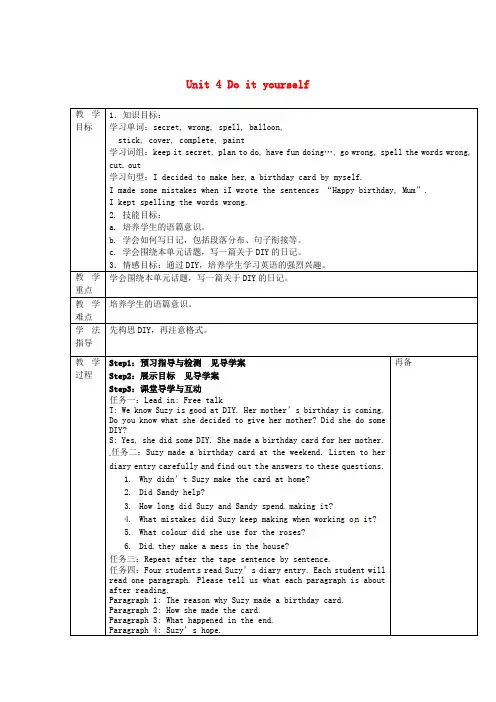
Unit 4 Do it yourself教学目标 1.知识目标:学习词汇:Instruction,had better,tool,brush,glue,rope,scissors,tape,DIY,exactly,stand for,repair,decorate,instead of,rose学习词组: had better do sth. , No problem, do it yourself, stand for, instead of ,make some paper roses学习句子:—What’s DIY exactly, Suzy?—It stands for “do-it-yourself”.When you do DIY, you make, repair or decorate things yourself instead of paying someone to d o it.She’s going to make some paper roses. She needs some paper, glue and a pair of scissors.You'd better get some tools.2. 技能目标:a. To learn to understand the conversation between Hobo and Eddie.b. To learn some tools for DIY.c. To learn to talk about DIY.3. 情感目标:培养亲自动手能力。
教学重点词汇识记运用,重点句型的运用。
教学难点Learn to talk about DIY.教学媒体录影机,多媒体,实物等教学过程Step1:预习指导与检测见导学案交流预习情况,讨论预习中存在的问题Step2:展示目标见导学案Step3:课堂导学与互动任务一:Free talkShow some pictures to talk about what is do-it-yourself.任务二:PresentationShow some pictures to talk about how to do it yourself.T: Eddie and Hobo want to do something by themselves.Ask: How can we do it yourself?DIY a sweater:如果你觉得自己的sweater太过单调,可以试着在上面画一幅画。
牛津译林版英语八上Unit 4《Do it yourself》(study skills)教学设计一. 教材分析牛津译林版英语八上Unit 4《Do it yourself》主要讲述了关于制作简易书签、相框和笔筒等手工DIY项目。
通过学习本单元,学生将掌握与手工制作相关的词汇和表达方式,学会如何描述制作过程,提高自己的动手能力和创新思维。
此外,本单元还引导学生关注环保,提倡利用废旧物品进行创作。
教材内容丰富,实用性强,有利于激发学生的学习兴趣和动手欲望。
二. 学情分析八年级的学生已经具备了一定的英语基础,能够听、说、读、写简单的英语句子。
在学习本单元时,学生需要掌握一些与手工制作相关的词汇和表达方式,同时能够运用所学知识描述制作过程。
此外,学生应具备一定的动手能力,能够根据教材提示完成相应的DIY项目。
在心理层面,学生对新奇有趣的手工制作活动充满好奇,有利于激发他们的学习兴趣和参与热情。
三. 教学目标1.知识目标:学生能够掌握与手工制作相关的词汇和表达方式,如“DIY”、“handmade”、“sewing”等;学会描述制作过程,如“cut”、“glue”、“pnt”等。
2.能力目标:学生能够听、说、读、写关于手工制作的内容,提高自己的英语应用能力;通过动手制作,提高自己的创新思维和动手能力。
3.情感目标:学生能够关注环保,学会利用废旧物品进行创作,培养良好的环保意识。
四. 教学重难点1.重点:学生能够掌握与手工制作相关的词汇和表达方式,学会描述制作过程。
2.难点:学生能够运用所学知识,独立完成DIY项目,并能够用英语进行展示和交流。
五. 教学方法1.任务型教学法:通过设置具有挑战性和实际意义的任务,激发学生的学习兴趣,提高学生的参与度和积极性。
2.交际型教学法:引导学生运用所学知识进行实际交流,提高学生的英语口语表达能力。
3.合作学习法:鼓励学生分组合作,共同完成DIY项目,培养学生的团队协作能力和创新思维。
牛津译林版八年级上册Unit 4《Do it yourself》(Grammar)教学设计一. 教材分析《Do it yourself》是人教版牛津译林八年级上册第五单元的一篇阅读文章,主要讲述了一个关于孩子们自己动手做玩具的故事,通过这个故事,让学生学会如何使用一般现在时描述习惯和能力。
本节课的主要目标是让学生掌握一般现在时的用法,并能运用到实际情景中。
二. 学情分析八年级的学生已经具备了一定的英语基础,对一般现在时有所了解,但部分学生可能对时态的运用还不够熟练。
学生在学习过程中,需要通过大量的练习来巩固知识点。
此外,学生对动手操作的活动感兴趣,可以通过实践活动提高学生的学习积极性。
三. 教学目标1.知识目标:让学生掌握一般现在时的结构(主语+动词原形)和用法,能够正确运用一般现在时描述自己的习惯和能力。
2.能力目标:培养学生阅读理解能力,提高学生运用英语进行交际的能力。
3.情感目标:培养学生热爱生活,勇于尝试自己动手解决问题的良好品质。
四. 教学重难点1.重点:一般现在时的用法和结构。
2.难点:一般现在时在实际情景中的运用。
五. 教学方法1.任务型教学法:通过完成具体任务,让学生在实践中掌握一般现在时的用法。
2.情境教学法:创设真实情境,让学生在实际情景中运用一般现在时。
3.游戏教学法:通过趣味游戏,激发学生的学习兴趣,提高学生的学习积极性。
六. 教学准备1.教材:《Do it yourself》相关材料。
2.多媒体设备:电脑、投影仪等。
3.教学道具:玩具、图片等。
4.教学课件:制作相关课件,包括图片、动画、游戏等。
七. 教学过程1.导入(5分钟)利用图片和动画引入话题,激发学生的学习兴趣。
提问学生:“你们喜欢自己动手做东西吗?为什么?”引导学生谈论自己喜欢的动手活动。
2.呈现(10分钟)呈现故事情境,让学生感知一般现在时的用法。
通过讲述故事,引导学生关注故事中孩子们自己动手做玩具的情节,提问学生:“他们是怎么做玩具的?”引导学生用一般现在时描述孩子们的行为。
Unit 4 Do it yourselfIntegrated skillsI. Teaching aims and learning objectivesBy the end of the lesson, students should be able to:1. obtain the key information from listening;2. express opinions about DIY;3.become more interested inDIY by listening and speaking.II. Teaching contents1. New words and phrases: grape, strawberry, spoon, salad, mix, add, example, leave correct,finished2.New structures: Cut some of the larger fruit into small pieces.III. Focus of the lesson and predicted area of difficultyObtain the key information from listening.Express opinions about DIY.IV.Teaching proceduresA How to make a fruit saladStep 1 Lead-in.Guess what we need for making a salad.T: Today we’ll going to learn how to DIY some delicious food, such as a fruit salad.T: If we want to make a fruit salad, what do we need? Fruit!Right, we may need bananas, apples, strawberries and grapes. Now read the new words after me: strawberry, grape. Of course we also need salad cream. Now read after me: salad cream. We need fruit and salad cream to make a fruit salad, but are they enough?【设计意图】启发学生思考做沙拉所需要的物品,既对下一个环节进行预判,也为下面的听力训练扫除了生词障碍。
Unit 4 Do it yourselfComic strip &Welcome to the unit一、教学目标1.掌握本课重点词汇及短语:instruction, had better, tool, glue, rope, scissors, tape, DIY, exactly, stand for, repair, instead of, rose2. 掌握本课重点句型:You’d better get some tools.What’s DIY exactly, Suzy?It stands for “do-it-yourself”.3. 通过听,获取Hobo和Suzy有关DIY的信息。
4. 用英语简单介绍DIY,并谈论自己的DIY经历。
5. 分析DIY的精神、理念和目的。
二、教学重点及难点重点:1. 设计听力活动,帮助学生获取Hobo和Suzy有关DIY的信息。
2. 引导学生用英语简单介绍DIY,并谈论自己的DIY经历。
难点:引导学生分析DIY的精神、理念和目的。
三、教学过程Task 1Step1 Warming-up1. Guide Ss to look at a picture about DIY and guess what it stands for.【设计意图】通过图片引导学生猜测DIY的含义,激发学生的学习兴趣。
2. Guide Ss to learn the origin of DIY in simple English with the help of pictures.【设计意图】以简单的英语,配以图片,使学生了解DIY的由来,及其意义。
3. Guide Ss to discuss their own DIY experience.【设计意图】引导学生讨论自己的DIY经历,帮助学生回忆和聚焦核心内容。
Step 2 Presentation1. Guide Ss to learn some new words.【设计意图】衔接前边的学习,引出工具的名称,利用图片教授新单词,为学生下边的听、说活动解决单词障碍。
Unit 4 Do it yourself教学目标 1.知识目标:学习词汇:Instruction,had better,tool,brush,glue,rope,scissors,tape,DIY,exactly,stand for,repair,decorate,instead of,rose学习词组: had better do sth. , No problem, do it yourself, stand for, instead of ,make some paper roses学习句子:—What’s DIY exactly, Suzy?—It stands for “do-it-yourself”.When you do DIY, you make, repair or decorate things yourself instead of paying someone to d o it.She’s going to make some paper roses. She needs some paper, glue and a pair of scissors.You'd better get some tools.2. 技能目标:a. To learn to understand the conversation between Hobo and Eddie.b. To learn some tools for DIY.c. To learn to talk about DIY.3. 情感目标:培养亲自动手能力。
教学重点词汇识记运用,重点句型的运用。
教学难点Learn to talk about DIY.教学媒体录影机,多媒体,实物等教学过程Step1:预习指导与检测见导学案交流预习情况,讨论预习中存在的问题Step2:展示目标见导学案Step3:课堂导学与互动任务一:Free talkShow some pictures to talk about what is do-it-yourself.任务二:PresentationShow some pictures to talk about how to do it yourself.T: Eddie and Hobo want to do something by themselves.Ask: How can we do it yourself?DIY a sweater:如果你觉得自己的sweater太过单调,可以试着在上面画一幅画。
Read the picture and match the tools with the pictures.(Students read and match them with pictures. Teacher avoids to present the words directly with pictures. Give the students chances to guess the meaning of places with context and pictures.)Discuss: Which picture do you want to choose? Why?任务三:Listen and answer:Listen to the conversation between Eddie and Hobo. What should Hobo do? (见课件) Watch and Practice in groups.Practice acting out the dialogue.任务四: Tell a story about Eddie with the help of some sentences.Hobo has a new house. What should Hobo and Eddie do? They read the i______________ first. Then they had b___________ get some t_____________. Next ,Hobo should make his new house by h________.任务五: Millie and Suzy are talking about DIY. Listen to their conversation and answer the questions.1. What’s DIY?2. What is Suzy going to do?3. What does Suzy need for her DIY?任务六: ExercisesStep4:总结提升 Words & phrase review1. You'd better (not) do sth.2. stand for3. or并列连词,表示选择关系,多中选一4. instead of5. enjoy doing sth.Step5:当堂反馈见导学案Step6:课后拓展见导学案Step7:布置作业1. Write about your DIY stories.2. To read the new words on Page 127。
3. To read the text on Page 44 and try to get a general idea。
再备教学反思课题Unit 4 Do it yourself ---Reading 1课时第二课时执教时间复备人教学目标 1.知识目标:学习词汇: crazy, terrible, once, mistake, pipe, fill, ceiling, shelf, Whoops, advise, course, already, instead, attend学习词组: be crazy about, make a mistake, put in, power cut, fill … with …, not only …,but (also), make something full of something else, take a course , have a power cut, keep on painting, hit a pipe, put up学习句子:1. Suzy’s cousin is crazy about DIY.2. He once tried to put in a brighter light in his bedroom, but he made a mistake.3. Another time, he wanted to put up a picture on his bedroom wall, but he hit a pipe and filled the room with water.4. Now the living room has not only blue walls but also a blue ceiling and floor.5. Stop it.2. 技能目标:a. To learn the new words and expressions in the article.b. To grasp the main idea of the article.c. To learn to describe Andrew’s working.3. 情感目标:引导学生的DIY意识。
教学重点 a. To learn the new words and expressions in the article.b. To grasp the main idea of the article.教学难点To learn to describe Andrew’s working.学法指导学会运用略读和精读相结合的方法去学习课文教学过程Step1:预习指导与检测见导学案Step2:展示目标见导学案Step3:课堂导学与互动任务一:Free talk1. Do you like DIY?2. Have you ever tried DIY? What is it?3. Do you want to take a course in DIY?任务二: Listen and finish Part B 1 on Page 45.Match the words on the left with the meanings on the right.任务三:Finish Part B 2 on Page 45.Suzy’s cou sin Andrew is crazy about DIY, but he is not very good at it. Listen to Suzy’s article and match the jobs he did with the problems he caused.任务四:Read and finish Part B 3 on Page 46.任务五:Watch and finish Part B 4 on Page 46.Step4:总结提升Work in several groups.Make up sentences with your partners with the phrases above. Speak them out to us. Let’s see which group is the most active.Step5:当堂反馈见导学案Step6:课后拓展见导学案Step7:布置作业1. Finish Exercise B4 on Page 46.2. Practice reading the story on Page 44.再备教学反思课题Unit 4 Do it yourself ---Reading 2课时第三课时执教时间复备人教学目标 1.知识目标:学习词汇: crazy, terrible, once, mistake, pipe, fill, ceiling, shelf, Whoops, advise, course, already, instead, attend学习词组: be crazy about, make a mistake, put in, power cut, fill … with …, not only … but (also), make something full of something else, take a course , have a power cut学习句子:1. Suzy’s cousin is crazy about DIY.2. He once tried to put in a brighter light in his bedroom, but he made a mistake.3. Another time, he wanted to put up a picture on his bedroom wall, but he hit a pipe and filled the room with water.4. Now the living room has not only blue walls but also a blue ceiling and floor.5. Stop it.2. 技能目标:a. To learn the new words and expressions in the article.b. To grasp the main idea of the article.c. To learn to describe Andrew’s working.3. 情感目标:引导学生的DIY意识。